Punch Your Neighbor Day: The World's 5 Strangest Holidays

Nothing makes people do crazier things than tradition. We'll put on costumes, decorate trees, or sing on command. And we do it all for no other reason than that people have always done it.
Just how far will people go? Here's five insane yet awesome traditional festivals and ceremonies that prove people will do just about any damned thing in the name of tradition:
Tinku "Punch Your Neighbor" Festival
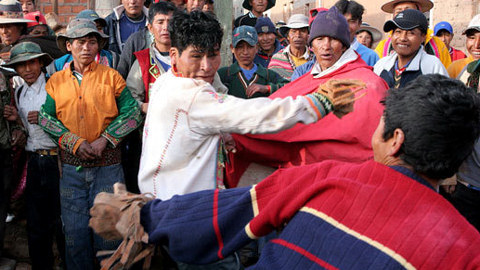
Where: Bolivia, particularly Potosi and Macha.
What:
Each May, high up in the Bolivian Andes mountains, thousands descend on the small city of Macha to partake in the traditional Tinku Festival. Tinku is a Quechua word meaning an encounter or a meeting, though when you take into account what actually happens at the festival, it should translate to "batter the fuck out of someone."

As a result many casual visitors have likely had this conversation on Tinku Festival day:
"Sweetie, look, there's a darling little town ahead. Let's stop for a coffee."
"That sounds simply divine. Gosh, it's popular! Look how many people are there. Oh, they're dancing! Look! How quaint!"
"Well I've always had a good eye for nice out-of-the-way places, Georgina. Remember that wonderful cafe in- OH MY GOD what ARE THEY DOING THEY'RE BEATING THE FUCK OUT OF EACH OTHER! Piss the shit! Jonathan! Jonathan back the fuck up, we're going home!"
For The Love of God, Why?
The Tinku Festivals aren't just people beating other people into a mushy pulp for fun. Instead it's an old religious festival based in pre-Hispanic times whereby the earth Goddess Pachamama demands blood to ensure a good harvest. The more blood, the better. And Bolivians, being a simple honest folk, could see no better way to get blood than to pummel the living cock out of their neighbors.
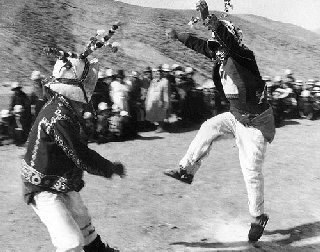
In the past, the fights frequently ended in death, as if one village had a poor harvest, the only way to guarantee a better one next year was to spill all the blood from your neighbors. Nowadays though, the festivals is policed, albeit lightly, and the police try and stop fights being more than one on one, and also to stop when the first blood has been shed.
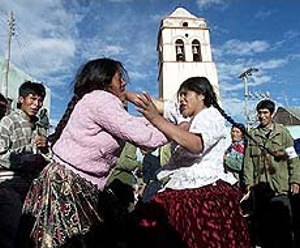
The Tinku festivals are believed to be at least 600 years old, pre-dating the Spanish conquest by a good hundred years. Of course Pagan ceremonies revolving around deities demanding sacrifice or blood as tribute are common throughout history, but we have to admit the Bolivians' way of doing it looks like a hell of a lot more fun.
The Haxey Hood Game
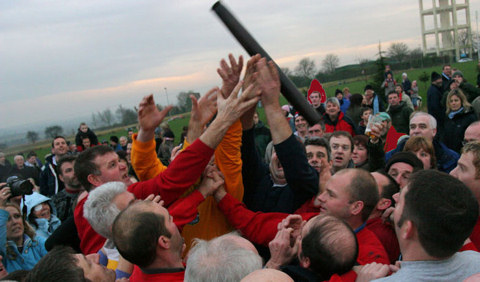
Where: The Parish of Haxey, in Lincolnshire, England.
What:
The Haxey Hood game involves a large throng of people trying to push a small leather tube (the "Hood"), towards one of four pubs in town, where it will stay until the following year's game. The day is wrapped with tradition dating back 650 years, and as such, it is imperative that competitors dress up like absolute dipshits.
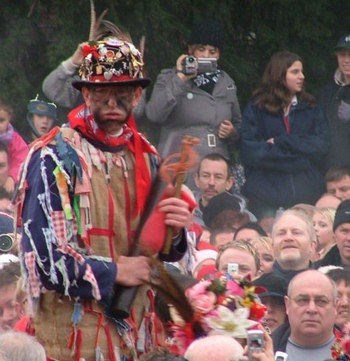
There are 13 main participants, the Lord, the Fool and 11 Boggins. It begins with a procession around the four pubs, and then the "smoking the fool" ritual. The original "smoking the fool" involved hanging the fool from a tree over a large fire while he gave a speech. Then he was cut down, landing straight in the flames out of which he had to scurry before being burned alive. These days they just have him stand in front of the fire so it's at least slightly less retarded.
Then, the game begins. The leather hood is released into the crowd, who has to get the tube to one of the four pubs. The hood cannot be thrown or run with. It has to move by "swaying", which means that whoever had a hold of the hood must be pushed and pulled towards the pubs by the crowd. As holding the hood is a necessity, wrestling it from someone then licking it when they try and grab it back is an acceptable tactic.
At times, upwards of three or four hundred people are in the "sway," or scrum trying to move the hood, and it frequently collapses into a pile of burly gentlemen, with one small, runty chap at the bottom shouting "get off, get off, I can't breathe! No, seriously, guys, I can't fucking breathe."
The sway, which drunkenly weaves through the village, tends to flatten anything in its path, from hedges and bushes to walls and children. The game usually takes a few hours before the hood is finally dragged into the pub whose owner gave out the most free beer.
For The Love of God, Why?
The story is that in the fourteenth century, Lady de Mowbray, the wife of a local landowner, John De Mowbray, was riding around her land when a gust of wind whipped her silk hood off and into a field. Thirteen laborers scampered around the muck and filth trying to rescue the hood, presumably having a merry time doing so, and then returned the hood to the lady. The lady deemed this so much fun that she gave up 13 acres of land for the chase to be re-enacted every year, which it has been ever since, though quite why everyone now needs to don stupid clothes and get blind drunk is a mystery.

The story may have some basis in truth, as there was a Lord de Mowbray living in the area 700 years ago, and he may well have had a wife. The rest may be a legend invented by someone who simply liked enormous, town-wide drunken brawls.
The Battle of the Oranges
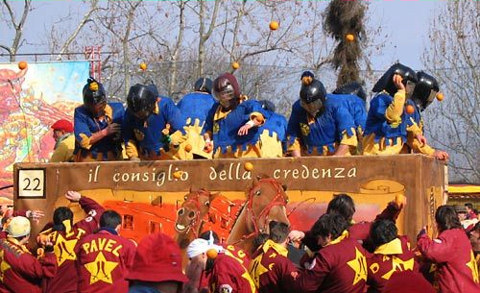
Where: Ivrea, Italy
What:
The battle of the Oranges is an event taking place during Il carnevale d'Ivrea, or the Carnival of Ivrea, when a load of stupidly dressed locals chuck oranges at each other. Italy exceeds its production quota of oranges as agreed by the European Union, so to keep the costs of oranges at a sensible price (god forbid that we live in a world of cheap oranges), they need to smash the fuck out of thousands of oranges each year, and what better way to do so than by using them to try to injure each other?
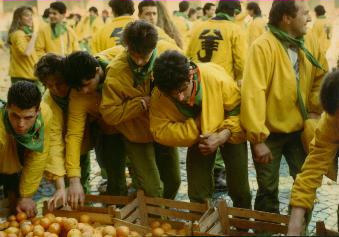
The competitors (up to 10,000) all wear brightly colored, loose fitting V neck tops, down which they stash their oranges. Sometimes the tops are in the color of a particular team, such as Diavoli (Devils), Morte (Death) and Picche (Spades). They line the streets, and chuck oranges at other men on horse-pulled trucks who roll past. The guys on the trucks are given football style-pads and have the advantage of throwing from an elevated position, but are still grossly outnumbered.
For The Love of God, Why?
This is celebrating a famous moment in Ivrea's history, a twelfth century revolt against a local tyrannical Count. In 1194, the fight for liberty consisted of a load of pissed off villagers throwing rocks at the henchmen of said local Count.
The exact story of what happened in 1194 is lost to time, but the legend is that the local Count, Conte Rainieri di Biandrate, made a law which allowed the horny bastard to have first crack at any newly-wed girl in the town, a la Braveheart.
However, unlike Braveheart, which resulted in a full-scale national revolt and culminated in a heroically inaccurate blockbuster movie, the Conte Rainieri di Biandrate's actions resulted in a load of pissed off Italians throwing first rocks and then oranges at each other.
Il Gioco del Ponte (The Game Of The Bridge)

Where: Pisa, Italy.
What:
The Game of the Bridge has taken place annually since February 22nd, 1568, albeit with sporadic breaks. It is the one thing which some claim Pisans feel most strongly about, except for pretending that a leaning, shabbily-built tower really is a fascinating tourist attraction.
The idea behind the game is for teams from the six historical quarters of the city to battle for possession of the bridge spanning the river Arno, which splits the historical city. Back in the good old days, possession for the bridge was determined by a violent game, which usually degenerated into bloody, brutal fisticuffs. Now though, EU regulations, health and safety laws, common sense and the sheer numbers of injury lawyers hanging around have ensured that the real fun has been negated. Instead of fighting, teams now compete by dressing up in frilly era costumes and trying to shove a huge wooden cart around.

The object of the game is for each 20 man team to push the seven-ton cart to the opposing side of the bridge in what is basically a glorified tug of war. It's hardly the most exciting event, but somehow, the teams are being cheered on by as many as 100,000 baying spectators at least some of which, we presume, must have only showed up because they've realized their crappy tower isn't going to fall over any time soon.
The cart is mounted on a 50 yard track, to facilitate easier pushing, probably because the only thing duller than watching 40 men push a huge wooden block on rails is watching 40 men push up against a huge wooden block just sitting there. At each end of the track is the flag bearing the team colors, and the team who pushes the trolley far enough to knock over the opposing team's flag wins. There are many more rounds of this, and the team with the most points at the end of the day are declared the enormous cart-pushing champions of the world.
For The Love of God, Why?
The exact origins of the game are lost, though some suggest that Pelops, the mystical founder of Pisa, began the game in order to recall his native Olympic Games (luckily the 50 yard trolley push has long since been cut from the Games' schedule).
Others claim that the Roman Emperor Hadrian, when he wasn't preoccupied in building fuck off great big walls, wanted to have some form of gladiatorial combat along the river Arno, and yet more think it may have begun from a battle between Pisans and Saccens which may have taken place on the bridge and could have involved a great deal of shoving.

Basically, no one quite knows, which is probably the best way when it comes to traditional festivals, because no one really gives a shit why it began so long as it involves a great deal of drinking, dressing up and playing some kind of manly game.
Perhaps there is no better example of this than ...
Antzar Eguna (Goose Day)

Where: Lekeitio, in the Basque region of Spain.
What:
Antzar Eguna or "Goose Day" has its roots in at least 350 years of Spanish insanity. Antzar Eguna involves a group of young Spaniards trying to decapitate a dead goose hanging from a rope in the middle of the town's harbor, which just goes to show how a nice party can get out of hand.

The tradition used to be celebrated up and down the country until people realized that it was just too fucking weird and they should just go back to doing normal stuff, like irritating a bull weighing half a ton. But, for some reason, the inhabitants of Lekeitio have hung on. Literally.
The rules say the contestants have to behead the goose using only their hands and arms. They try this, approaching the dangling goose in a rowboat, grabbing its neck, then falling into the harbor waters. Bystanders then yank the rope on which the goose is tied, heaving both bird and man up into the air, before dropping them back into the water again. The idea is to tear the goose's head off using that jerking motion, a motion not dissimilar to the one you might use to get a stupid child's head out of a bucket.
If the youth is jerked free from the bird and plops into the harbor, he fails and another person has a go. If he manages to hold on to the bird despite the best efforts to shake him off and also manages to wrench the head off, he wins, and the prettiest girls in town flock into his goose blood-streaked arms.
For The Love of God, Why?
No one seems to know. Really, would any explanation suffice?
This is done as part of the festival of St. Antolin, but there appears to be no record of the saint decapitating geese at any time during his ecclesiastical career, or even sitting down and thinking it might just be a fun idea for a party game.
It appears they just do it for the hell of it, and that may be the best reason of all.
If you liked that, you'll almost certainly enjoy David's look at The 10 Most Insane "Sports" From Around the World.